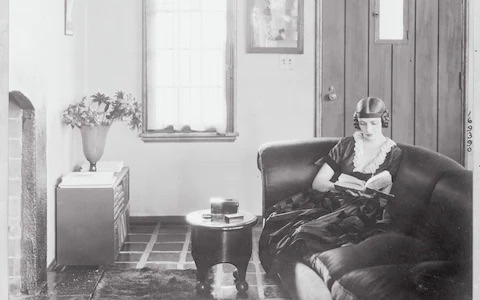Villa Valentino (1922-1951)
- Sep 2, 2022
- 4 min read
Updated: Feb 19, 2025
The most famous resident of Whitley Heights, Rudolph Valentino lived at 6776 Wedgewood Place with second wife Natacha Rambova and an imported pack of dogs featuring German Shepards, Italian mastiffs, and Spanish greyhounds.

The Sheik actor supposedly fell in love with the neighborhood while driving by one day—its Mediterranean architecture reminded Valentino of his native Italy. In 1922, he purchased four plots of land for his marital estate with Rambova.
Built into a hillside, the two-story, eight-room palatial villa was fit for a Hollywood king (and designed by his queen): black marble flooring, scarlet cushions salvaged from the fall of Imperial Rome, a purple and gold bedroom, and a veranda that ran along the west side of the property with sweeping views of Cahuenga Pass (pictured below).

Valentino lived so close to his studio, Famous Players-Lasky, he often came home for lunch. A neighbor recalled seeing the actor driving past one afternoon, holding a sandwich out to two dogs to share in the back seat.
In the evenings, he could be spotted walking his four-legged friends (three of whom he received from neighbor Francis X. Bushman, a breeder of Great Danes) around the hill, sometimes joined by Louis Lewyn, the producer-director who lived nearby on Lloyd Lane.

Bushman gifted Valentino much more than dogs. He also lent the younger sex symbol two of his home’s garages at nearby 6737 Whitley Terrace (pictured at left). The gearhead only had a one-car garage on Wedgewood—not nearly enough for his fleet, which included an Avion Voisin (with cobra hood ornament from Douglas Fairbanks), Isotta Fraschini, Chevrolet Roadster, Ford truck, and restored Cadillac touring car.
A natural mechanic, Valentino enjoyed tinkering with his expensive toys and could often be found at Bushman’s decked out in oil-slicked overalls. The actor spent so much time in his borrowed garage, a postman delivering fan mail knew exactly where to find him.

In 1925, Los Angeles Times columnist Alma Whitaker drove a 15-year-old fan named Eleanor up to Whitley Heights hoping for a glimpse at Valentino, who they found “disheveled” as he rolled out from beneath his favorite French car. “His hands were much, much too dirty to shake,” Whitaker recalled of the actor, who excitedly gabbed about transmissions, great shifts, and clutches.

Once Valentino’s romance with Rambova went south, he headed west—to his Beverly Hills estate, Falcon Lair.
But first, the estranged couple hashed out their split at the Whitley Heights love nest, reported the New York Daily News on Aug. 21, 1925. In a statement to the gossip rag, the actor refused to concede divorce: “Mrs. Valentino and I have agreed on a marital vacation.”
Although Valentino only spent a few years on Wedgewood, his folklore is forever imprinted on Whitley Heights. As early as 1933, “sightseeing busses” carrying tourists passed by the famed residence. (Nine decades later, locals still proudly brag “Valentino lived here”—and there’s even a 1960s fourplex on Whitley Terrace named after him.)

Following the actor’s death in 1926, the property went up for auction, but failed to secure a buyer for years. Why? Some blamed termites, others claimed the home was haunted.
In a 1938 interview, screenwriter Kay Van Riper recounted her own spooky experience the very day she moved in to Valentino’s former home. While hanging a photo in the den, she heard a buzzer and went to the front door. No one was there. She walked back to the den. The buzzer sounded again. A second time, no one was at the door. She later discovered a button hidden under the carpet by the fireplace—and every time someone stepped on it, a buzzer rang in the servant quarters.

In the late 1930s, 6776 Wedgewood finally had an official owner, one who was dedicated to preserving its legacy: Maybelline founder Thomas Lyle Williams. With his partner Emory Shaver, the two transformed the forgotten relic into a luxury compound Valentino surely would have loved.
The massive renovation project converted the garage into a bedroom, reimagined the main entryway (now decorated with imported tile), and added an ornamental iron balcony that spanned the entire top floor to gaze down on all the amusement in the backyard: a brand new pool and bathhouse, surrounded by lush landscaping.
A little more than a decade later, 6776 Wedgewood was gone. One of the last holdouts in the Battle of Whitley Heights, Villa Valentino was razed to make way for the freeway in 1951—but not before vandals picked it clean.
As the late silent film star’s home sat abandoned ahead of demolition, fans and vandals alike descended on it with sledge hammers and chisels, on the hunt for “souvenirs.”

They didn’t just take anything that wasn’t nailed down … they literally took things that were nailed down: a black marble slab over the fireplace, mirrored wall panels, decorative tile, plumbing fixtures, imported iron railing that wound down the terraced garden, even the window shutters.
When actress Eleanor Parker toured the empty mansion in 1950, while making the biopic Valentino, she was shocked by the squalor. In the bedrooms, mirrors were shattered and gold leafing torn off walls. The pool was drained of water and filled with trash and rodents.

Eventually, a security guard was hired to protect the famous home from further pilfering.
By the time demolition crews arrived, Villa Valentino (as Williams had named it) was a shell of its former self, picked apart by vandals piece-by-piece. Who knows where any of the “souvenirs” ended up.
However, an ornate column salvaged ahead of the wrecking ball can be found at a nearby home in Whitley Heights.
There’s another remnant of Villa Valentino still haunting 6776 Wedgewood Place. Somehow, part of the foundation was left behind and can be seen along the southbound freeway—and across the 101 from Iris Circle.

























